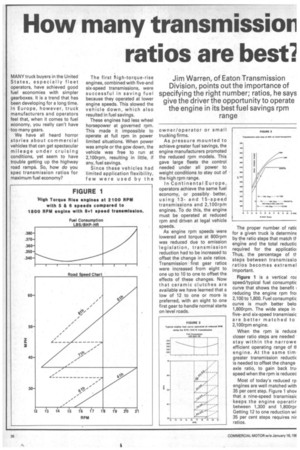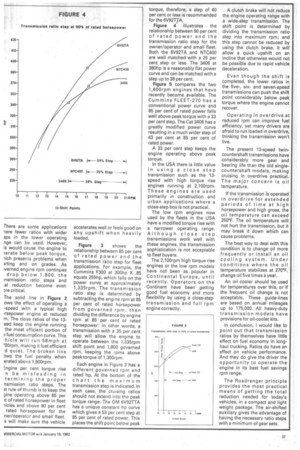How many transmission ratios are best?.
Page 32

Page 33

If you've noticed an error in this article please click here to report it so we can fix it.
MANY truck buyers in the United States, especially fleet operators, have achieved good fuel economies with simpler gearboxes. It is a trend that has been developing for a long time. In Europe, however, truck manufacturers and operators feel that, when it comes to fuel economy, you really can't have too many gears.
We have all heard horror stories about commercial vehicles that can get spectacular mileage under cruising conditions, yet seem to have trouble getting up the highway road ramps. So, how do you spec transmission ratios for maximum fuel economy?
The first nigh-torque-rise engines, combined with five-and six-speed transmissions, were successful in saving fuel because they operated at lower engine speeds. This slowed the vehicle down, which also resulted in fuel savings.
These engines had less wheel horsepower at governed rpm. This made it impossible to operate at full rpm in power limited situations. When power was ample or the gcw down, the vehicle was free to run at 2,100rpm, resulting in little, if any, fuel savings.
Since these vehicles had limited application flexibility, few were used by the owner/operator or small trucking firms.
As pressure mounted to achieve greater fuel savings, the engine manufacturers promoted the reduced rpm models. This gave large fleets the control needed under all power to weight conditions to stay out of the high rpm range.
In Continental Europe, operators achieve the same fuel economy, or possibly better, using 13and 15-speed transmissions and 2,100rpm engines. To do this, the engine must be operated at reduced rpm and driven at legal vehicle speeds.
As engine rpm speeds were lowered and torque at 800rpm was reduced due to emission legislation, transmission reduction had to be increased to offset the change in axle ratios. Transmission first gear ratios were increased from eight to one up to 10 to one to offset the effects of these changes. Now that ceramic clutches are available we have learned that a low of 12 to one or more is preferred, with an eight to one first gear to handle normal starts on level roads.
The proper number of ratic for a given truck is determin€ by the ratio steps that match tlengine and the total reductic required for the applicatio Thus, the percentage of if steps between transmissio ratios becomes extremel important.
Figure 1 is a vertical rcN speed/typical fuel consumptic curve that shows the benefit reducing the engine rpm fro 2,100 to 1,800. Fuel consumptic curve is much better belo 1,800rpm. The wide steps in fiveand six-speed transmissic are better matched to 2,100rpm engine.
When the rpm is reduce closer ratio steps are needed stay within the narrowe efficient operating range of ti engine. At the same tim greater transmission reductic is needed to offset the change axle ratio, to gain back trui speed when the rpm is reducec Most of today's reduced rp engines are well matched with 35 per cent step. Figure 1 shov that a nine-speed transmissic keeps the engine operatir between 1,300 and 1,800rpr Getting 12 to one reduction wi 35 per cent steps requires nir ratios. There are some applications here fewer ratios with wider aps in the lower operating nge can be used. However, is would cause the engine to )erate below peak torque, lich presents problems when Ming and on grades. As iverned engine rpm continves
drop below 1,800, the insmission ratio steps and ;al reduction become even 3re critical.
The solid line in Figure 2 ows the effect of operating a -speed with a typical high asepower engine at reduced m. The close ratios of the .13eed keep the engine running the most efficient portion of 3 fuel consumption curve. This !hide will run 58mph at TOrpm, making it fuel efficient d quiet. The broken line ows the fuel penalty when erated above 1,900rpm.
Engine per cent torque rise n be misleading in !termining the proper nsmission ratio steps. The st rule of thumb is to keep the gine operating above 85 per it of rated horsepower in fleet iicles and above 90 per cent rated horsepower for the ner/operator and small fleet. 's will make sure the vehicle accelerates well or feels good on any upshift when heavily loaded.
Figure 3 shows the relationship between 85 per cent of rated power and the transmission ratio step for fleet applications. For example, the Cummins F300 at 300hp X .85 equals 255hp, which falls on the power curve at approximately 1,335rpm. The transmission ratio step is determined by subtracting the engine rpm at 85 per cent of rated horsepower from governed rpm; then dividing the difference by engine rpm at 85 per cent of rated horsepower: in other words, a transmission with a 35 per cent step will allow the engine to operate between the 1,335rpm shift point and 1,800 governed rpm, keeping the rpms above peak torque of 1,300rpm.
Each engine in Figure 3 has a different governed rpm and rated hp. At the bottom of the chart the maximum transmission step is indicated. In each case, the cruising ratios should not extend into the peak torque range. The GM 6V92TTA has a unique constant hp curve which gives a 53 per cent step at 85 per cent of rated power. This places the shift point below peak torque, therefore, a step of 40 per cent or less is recommended for the 6V92T1A.
Figure 4 illustrates the relationship between 90 per cent of rated power and the transmission ratio step for the owner/operator and small fleet. Both the 8V92TA and NTC400 are well matched with a 25 per cent step or less. The 3406 at 380hp is a reasonably flat power curve and can be matched with a step up to 38 per cent.
Figure 5 compares the two 1,600rpm engines that have recently become available. The Cummins FLEET-270 has a conventional power curve and 85 per cent of rated power falls well above peak torque with a 33 per cent step. The Cat 3406 has a greatly modified power curve resulting in a much wider step of 43 per cent at 85 per cent of rated power.
.A 33 per cent step keeps the engine operating above peak torque.
In the USA there is little value in using a close step transmission such as the 13speed with high torque rise engines running at 2,100rpm. These engines are used primarily in construction and urban applications where a close-step box is not practical.
The low rpm engines now used by the fleets in the USA have a modified torque rise with a narrower operating range. Although close step transmissions work well with these engines, the transmission sophistication is not acceptable to fleet buyers.
The 2,100rpm high torque rise engines or the low rpm models have not been as popular in Continental Europe, until recently. Operators on the Continent have• been getting good fuel economy and more flexibility by using a close-step transmission and full rpm engine correctly. A clutch brake will not reduce the engine operating range with a wide-step transmission. The shift point is determined by dividing the transmission ratio step into maximum rpm; and this step cannot be reduced by using the clutch brake. It will allow a quick upshift on an incline that otherwise would not be possible due to rapid vehicle deceleration.
Even though the shift is completed, the lower ratios in the five-, sixand seven-speed transmissions can push the shift point considerably below peak torque where the engine cannot recover.
Operating in overdrive at reduced rpm can improve fuel efficiency, yet many drivers are afraid to run loaded in overdrive, thinking the transmission won't live.
The present 13-speed twincountershaft transmissions have considerably more gear and bearing life than the old singlecountershaft models, making cruising in overdrive practical. The major concern is oil temperature.
If the transmission is operated. in overdrive for extended periods of time at high horsepower and high gross, the oil temperature can exceed 250°F. The oil temperature will not hurt the transmission, but it may break it down which can cause problems.
The best way to deal with this condition is to change oil more frequently or install an oil cooling system. Under conditions where the oil temperature stabilizes at 270°F, change oil five times a year.
An oil cooler should be used for temperatures over this, or if the frequent oil change is not acceptable. These guide-lines are based on annual mileages up to 175,000. All heavy-duty transmission models have provisions for oil-cooler kits.
In conclusion, I would like to point out that transmission ratios by themselves have little• effect on fuel economy in longhaul trucking. Ratios do have an effect on vehicle performance. And they do give the driver the opportunity to operate the engine in its best fuel savings rpm range.
The Roadranger principle provides the most practical means of getting the total reduction needed for today's vehicles, in a compact and light weight package. The air-shifted auxiliary gives the advantage of having the necessary ratio steps with a minimum of gear sets.










































